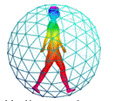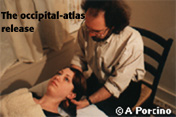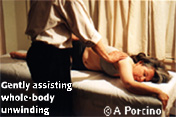
Hellerwork
- Bodywork
- Movement
- Dialogue
- Session 1
- Session 2
- Session 3
- Session 4
- Session 5
- Session 6
- Session 7
- Session 8
- Session 9
- Session 10
- Session 11
Cranial Sacral Therapy
![]()
Cranial Sacral Therapy
Craniosacral Therapy developed from the osteopathic tradition of manual medicine. The cranial rhythm was first discussed in the 1920's by Dr. W. Sutherland D.O.(doctor of osteopathy). Over the past two decades Dr. J.Upledger, D.O., has refined craniosacral therapy and introduced it to medical establishments and the scientific community around the world. Several other doctors and practitioners have added to and refined specific approaches and understanding of the work.
The technique is based on the idea that the motion of the subtle pulses of the cerebral spinal fluid (the fluid system that nurtures our central nervous system, from the brain to the tailbone) needs to be as free as possible for healthy functioning. Injuries, muscular strain, and tension can affect this cranial motion both locally and throughout the body via the connective tissue network. Craniosacral Therapy is a gentle, hands on method of correcting or normalizing and freeing this motion. The therapy is also based on the idea that micro-movements in the skull matter. Measurements of the skull during treatment haven't found anything... but most people find the work extremely relaxing and sometimes usefully therapeutic.
The recipient lays comfortably and fully clothed on the treatment table. The therapist's gentle pressure assists the recipient's body in making self-corrections. Rarely is the pressure used more than 5 grams (the weight of a nickle). Working with the cranio system induces a very relaxing state in which the release of connective tissue happens readily.

This is one of the more "dramatic" moments in the treatment.
Unwinding
&
Combining these methods with Hellerwork
The process of unwinding proceeds in a simple manner. When first experienced, the practitioner induces the unwinding by removing the effects of gravity, usually by supporting the body part in the air. The practitioner can then "listen" for and follow any movement indicated by uneven tension in the muscle or connective tissue.

While I may use the protocol work predominantly in the sixth and seventh Hellerwork sessions, the freeform release work can be used any time. Sometimes when connective tissue release is not occurring easily with Hellerwork, the change in modality to unwinding will make the tissues release with ease. It has also taught me that the Hellerwork can be gentle and still be effective.